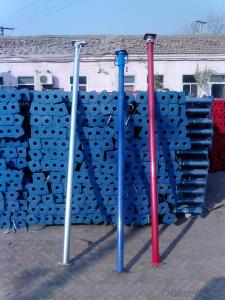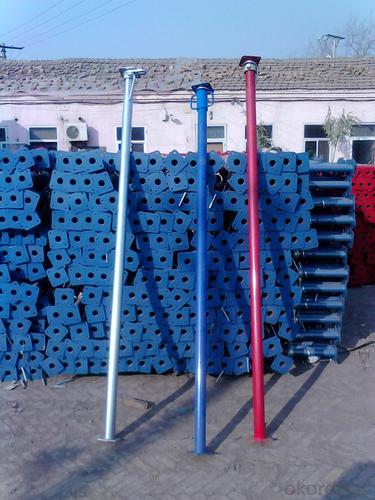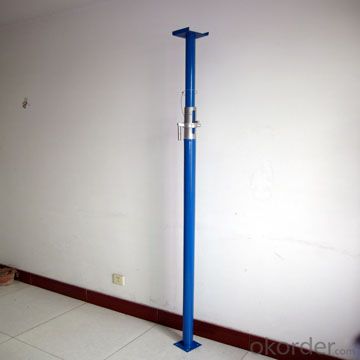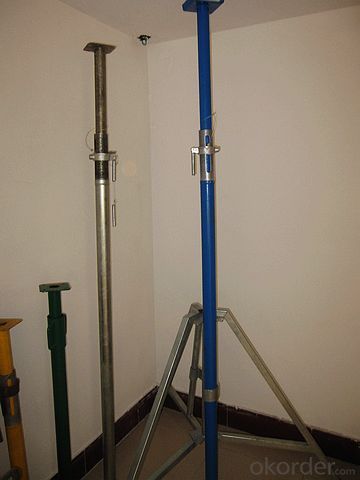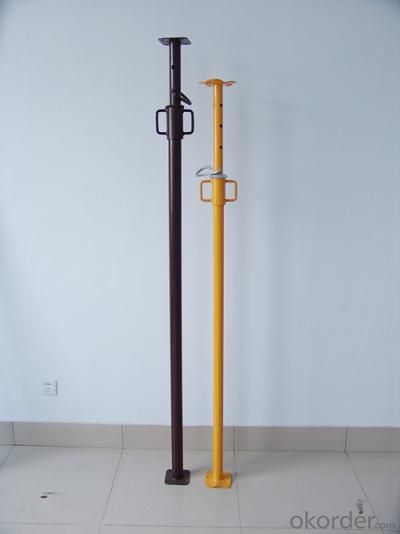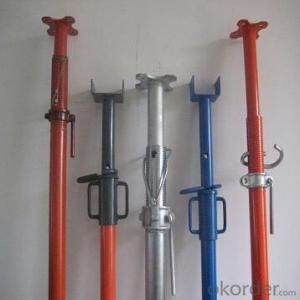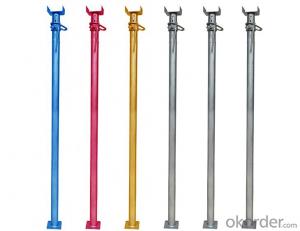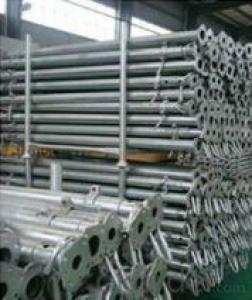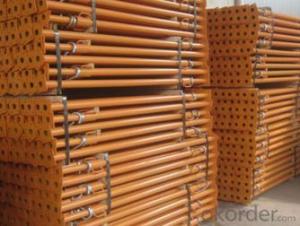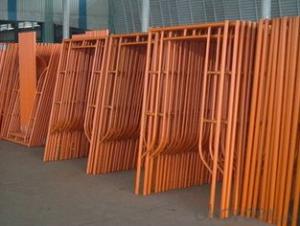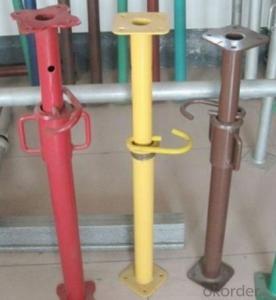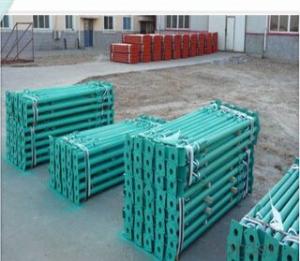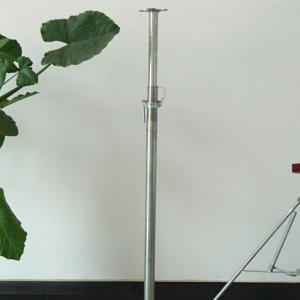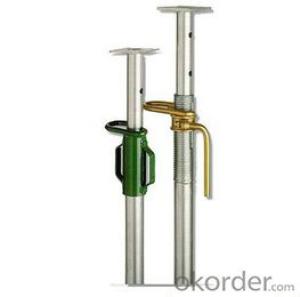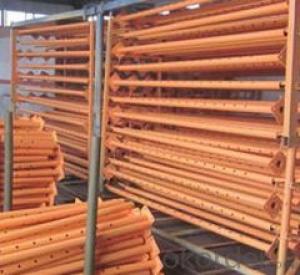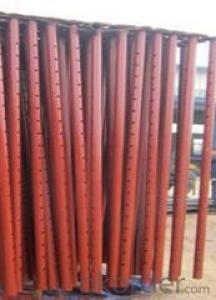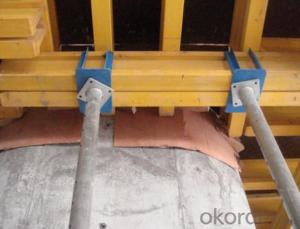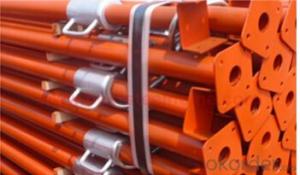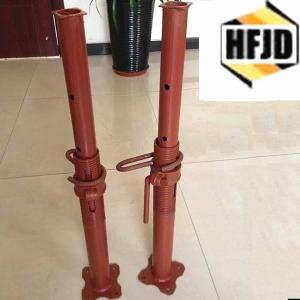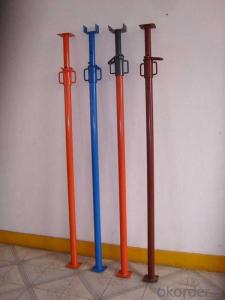scaffold steel props for constrcution adjustalbe props
- Loading Port:
- Tianjin
- Payment Terms:
- TT OR LC
- Min Order Qty:
- 1000 pc
- Supply Capability:
- 20000 pc/month
OKorder Service Pledge
Quality Product, Order Online Tracking, Timely Delivery
OKorder Financial Service
Credit Rating, Credit Services, Credit Purchasing
You Might Also Like
the scaffolding steel props for construction
adjustable : 2000-3500mm, 2mm, 11kg,
surface: powder coated, anyone color.
delivery time: 10 days
material:Q235
2200-4000mm; 1800-3000mm; 2500-4500mm ; 3000-5500mm
Adjustable steel support for building template support
You can choose any color
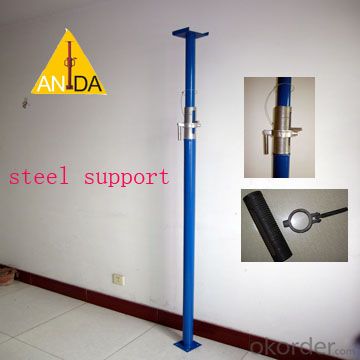
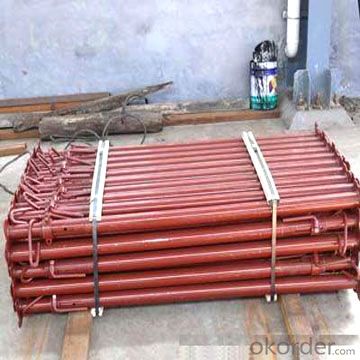

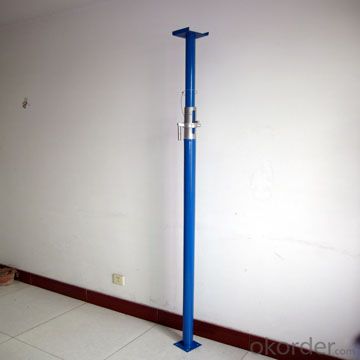
- Q: Are steel props suitable for use in the construction of theaters?
- Yes, steel props are commonly used in the construction of theaters due to their durability, strength, and stability. They provide necessary support for stage sets, backdrops, and lighting equipment, ensuring the safety and structural integrity of the theater.
- Q: Are steel props compatible with different types of scaffolding?
- Yes, steel props are compatible with different types of scaffolding. They can be easily adjusted to fit various heights and configurations, making them versatile and suitable for use with different scaffolding systems.
- Q: Can steel props be used in temporary support of walls?
- Yes, steel props can be used in the temporary support of walls. Steel props, also known as adjustable steel props or acrow props, are commonly used in construction to provide temporary support to walls, ceilings, and other structures during renovation or construction work. They are designed to be adjustable in height and can be easily installed and removed. Steel props are made of strong and durable steel, making them capable of withstanding heavy loads. They provide stability and support to walls, ensuring that they remain upright and secure during construction or repairs. Overall, steel props are an effective and reliable solution for temporary wall support in construction projects.
- Q: Can steel props be used for temporary support during foundation work?
- Yes, steel props can be used for temporary support during foundation work. Steel props are strong and sturdy, making them suitable for providing temporary support and stability during construction or renovation of foundations. They can be adjusted in height and are often used to support walls, beams, and other structures during the foundation construction process.
- Q: How do you determine the number of steel props required for a project?
- Determining the number of steel props required for a project involves taking into account various factors, including the load-bearing capacity of the props, the height and spacing requirements, and the overall structural design of the project. First and foremost, it is essential to ascertain the necessary load-bearing capacity of the steel props. This can be accomplished by calculating the total weight or load that the props will have to support. This encompasses the weight of any construction materials, equipment, or structures that will be placed on the props. Following that, the height and spacing requirements of the props must be considered. The height will be dependent on the specific project requirements, such as the height of the ceilings or the number of floors. The spacing between the props will be contingent upon the load distribution and the structural design of the project. Generally, the distance between the props should be such that it evenly distributes the load and provides ample stability. Also of importance is the type and size of the steel props. Different projects may necessitate different types of props, such as adjustable or fixed props, depending on the construction needs. The size of the props will be determined by the required load-bearing capacity and the height of the project. To determine the number of steel props required, the total load can be divided by the load-bearing capacity of each prop. This will yield an estimate of the minimum number of props needed. However, it is advisable to incorporate a safety margin to ensure the stability and safety of the structure. This can be achieved by increasing the number of props or employing props with higher load-bearing capacities. Lastly, it is vital to consult with structural engineers or construction experts who can provide precise calculations and recommendations based on the project's requirements and regulations. They can review the structural design and offer professional guidance on the appropriate number and specifications of steel props needed for the project.
- Q: Can steel props be used in the construction of concert halls?
- Yes, steel props can be used in the construction of concert halls. Steel props are commonly used in construction for providing temporary support to structures during the construction process. They are adjustable and can be easily installed and removed as needed. In the case of concert halls, steel props can be used to support the weight of heavy equipment, stages, lighting rigs, and other elements that need support during construction. Additionally, steel props are known for their strength and durability, making them suitable for handling the load-bearing requirements of a concert hall. However, it is important to ensure that the design and installation of steel props are in accordance with the specific requirements of the concert hall to ensure safety and structural integrity.
- Q: Are steel props suitable for supporting formwork systems?
- Yes, steel props are suitable for supporting formwork systems. Steel props provide strong and reliable support, making them ideal for handling heavy loads and ensuring stability during the construction process. Additionally, steel props are adjustable, allowing for easy customization and efficient use in various formwork applications.
- Q: What are the safety certifications and standards for steel props?
- Some safety certifications and standards for steel props include the British Standard BS 4074:1982, which outlines the requirements for adjustable steel props used in temporary structures. Additionally, the European Standard EN 1065:1999 provides specifications and safety guidelines for adjustable steel props used in construction. These certifications ensure that steel props meet certain quality and safety standards to minimize the risk of accidents and ensure the structural integrity of temporary support systems.
- Q: What are the guidelines for the proper inspection and maintenance of steel props?
- The guidelines for the proper inspection and maintenance of steel props are as follows: 1. Regular Inspection: Steel props should be inspected regularly to identify any signs of wear, damage, or deformation. This inspection should include a visual examination of the prop's components, such as the outer tube, inner tube, and threaded sections. 2. Checking for Structural Integrity: Inspectors should ensure that the steel props are structurally sound and capable of safely supporting the intended load. This can be done by checking for any cracks, bends, or excessive corrosion on the prop's surface. 3. Lubrication: Proper lubrication of steel props is essential for their smooth operation and longevity. Inspectors should check if the prop's threaded sections and adjustment mechanism are adequately lubricated to prevent binding or seizing. 4. Load Capacity Verification: It is crucial to verify that the steel props' load capacity matches the requirements of the specific application. This can be done by checking the manufacturer's documentation or consulting load capacity charts provided by the prop's manufacturer. 5. Stability Check: Inspectors should ensure that the steel props are stable and properly aligned during use. This can be achieved by verifying that the props' base plates or footplates are in good condition and adequately positioned to distribute the load evenly. 6. Cleaning: Steel props should be cleaned regularly to remove any dirt, debris, or other foreign substances that could affect their performance. This can be done using a mild detergent and water, followed by thorough drying to prevent corrosion. 7. Storage: Proper storage of steel props is essential to prevent damage and ensure their longevity. They should be stored in a dry, well-ventilated area, away from any corrosive substances or extreme temperatures. 8. Record-Keeping: It is recommended to maintain a record of all inspections and maintenance activities performed on the steel props. This record should include the date of inspection, any findings or issues identified, and the actions taken to address them. By following these guidelines, the proper inspection and maintenance of steel props can be ensured, promoting safety and prolonging the lifespan of these crucial construction supports.
- Q: Are steel props commonly used in bridge construction projects?
- Yes, steel props are commonly used in bridge construction projects. Steel props, also known as temporary supports, are vertical columns made of steel that are used to provide temporary support to structures like bridges during construction. They are used to carry the weight of the bridge deck and other construction materials until the bridge is fully completed and can support itself. Steel props are preferred in bridge construction projects due to their strength, durability, and ability to bear heavy loads. They are adjustable and can be easily installed and removed, making them a cost-effective and efficient choice for temporary support in bridge construction.
Send your message to us
scaffold steel props for constrcution adjustalbe props
- Loading Port:
- Tianjin
- Payment Terms:
- TT OR LC
- Min Order Qty:
- 1000 pc
- Supply Capability:
- 20000 pc/month
OKorder Service Pledge
Quality Product, Order Online Tracking, Timely Delivery
OKorder Financial Service
Credit Rating, Credit Services, Credit Purchasing
Similar products
Hot products
Hot Searches
Related keywords
